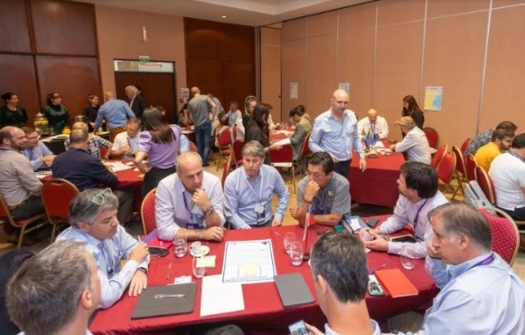For the first time in 30 years, in Argentina, took place the World Congress of Prunes organized by the Prune Association (IPA), the world’s most important event in the prune industry.
At the beginning of November, in Mendoza, a great number of visitors and speakers gathered; of course, the Chilean delegation was the largest together with the local delegation. They agree that it was a good congress, with great attendance and representatives form every country. It was well organized and set in a place that combines country and agro-industry.
Paulo Estrada, product manager at GoodValley, said that the presentations were excellent, with a lecture on leadership and innovation that was a real contribution to the Congress. “May be, the only thing I missed, was to see a farm in normal conditions, not top of the line like the ones we saw. I would have liked to visit a more typical Argentinian farm, without anti-hail netting, without frost control, and average size orchard or a bit smaller, subject to normal inclement Argentinian weather”, he said.
For his part, Agustín Marín, Onizzo’s general manager, agrees in that they wanted to know more about the reality in Argentina, “one that has lights and shadows. The good part is that there are farmers investing a lot in technology, with awesome orchards even protected from hail by roofs. On the other hand, there are farmers with less resources who with great effort carry out their crops. We are talking about significative differences in productivity: from 3,000 to 10,000 kilos per hectare”.
Of course, the future looks good for Argentina. “there is interest, desire to invest (in technologies like nettings and webs to mitigate the effects of the weather) and what we saw was a good final product. For us, this is important because they are direct competitors, but they could be providers in certain cases; they have their limitations because they have few international agreements to sell their fruit. This could represent an opportunity for Chile, if we collaborate with them”.
Pablo Campino, member of the technical committee of Chileprunes and executive at Pacific Nut adds that the challenges of the Argentinian prunes are two: “open markets; today they have 5 or 6 while Chile has 70. For sure they must go to the world to sell their fruit. And they need technified irrigation, because the drought affects them as well (they have 20% of the terrain with technified irrigation and we have 80%). They know that aligning institutions in this direction they will solve their problems in short time”.
What Campino did miss is a better strengthening and alignment of the country reports from the participating countries in a single format, “we had to dig a bit to access the information”.
China…. A threat or an opportunity?
The member of the technical committee at Chileprunes also highlights from what he heard what is happening with China. “It has always been airtight regarding the number of plantations they have, but know it is a fact that the surface they have planted is practically the same the world has among California, Chile, France, Argentina and a couple of small countries. The big question is to know if it is a treat or an opportunity… time will tell”.
Estrada adds that China makes the challenges of the prune market not completely clear. “We do not know what is going to happen with that country and we are not clear as to how to talk about this subject with California, France and Argentina”.
With uncertainty or without it, China’s demand continues to grow buying fruit that before went to other markets. “It is key to be present in China. Without the Chinese it would be very difficult to sell all our production. And while most of the countries are facing a drop in their productions we manage to maintain and even grow”, adds Agustín Marín.
Another important subject addressed by the interviewees is that the global consumption of prunes seems to be stagnant; and if the world population increases it means that the per capita prune consumption decreases, even though we are talking about a super-food that can be very well marketed the way Chile is doing it in India.
“But as producers, in general, we are not using this well as a marketing strategy; the endless list of benefits for human health. There is a big part of the population, Generation Z and Millennials (30% of the population) that do not eat prunes even though they are consumers looking for healthy food”, adds Campino.
Finally, he highlights the huge potential that Chile has with the D’agen variety considering that the main actors, leaving China aside, that belong to IPA, are all going downwards in their productions. This considering the lack of new surfaces or plantations and the decrease in production due, mainly, to weather factors.
In Chile, despite weather events, we have seen that the surfaces, thanks to the good returns of the last years, have slightly increased. We know that we have the ideal conditions, regarding soil and weather, to produce good volumes and calibers. This represents an important commercial attraction for our producers who can get good profits. In this regard I think we have significative competitive advantages as a country.
Argentina’s voice
For his part, the coordinator of the Prune Industry Cluster from Mendoza, owner of the organizing institution, Francisco Araujo, explained that this is the first IPA Congress in Argentina during the 34 years this organization has. “We coordinate efforts to promote the consumption of prunes and to develop new market opportunities, always with a vision of international cooperation and responsibility with the future of the sector”.
He added that there came seven delegations of country members of IPA and that it was “an honor to receive the delegations of Spain and China”. He stressed the idea that “there are not so many productive chains that have a space for discussion like the one we have, where we can work together the most important themes regarding our industry, from the sustainability challenges to opening new markets”.
In Argentina, the planted cultivation area is about 10,000 hectares and it is mainly in the provinces of Mendoza (80% of the planted cultivation area), San Juan, Río Negro and Neuquén, where the weather is favorable for its development.
The annual plum production in Argentina varies depending on the weather and foreign demand. In good years, the production can be higher than 100,000 tons although during droughts, frosts, strong winds (called Zonda in this country) the amount can be less than half.



